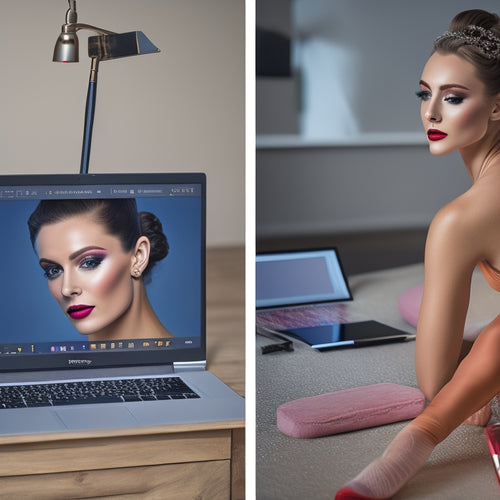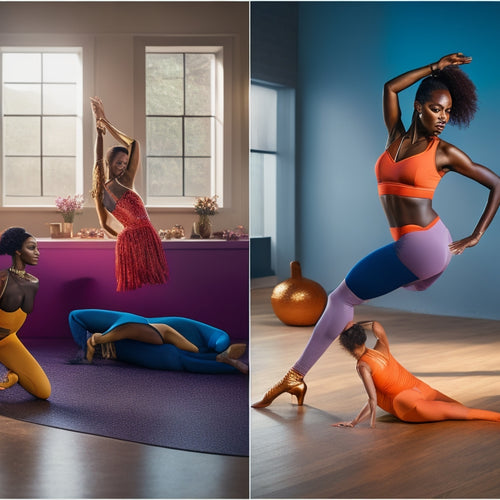
Best Ballet Shoes for Beginners
Share
The best ballet shoes for beginners should prioritize comfort, support, and flexibility. Look for well-fitted shoes that hug your foot snugly without pinching. Consider materials like leather for durability or canvas for breathability, depending on your preference. Guarantee your shoes offer adequate arch support and cushioning to protect against injuries. A good grip is essential, so choose shoes with flexible soles that provide traction on various surfaces. Take the time to measure your feet accurately to find the right size. Choosing the right shoes can boost your practice, and there's much more to uncover about enhancing your ballet experience.
What You Need to Know
- Choose shoes made of high-quality materials like leather or canvas for enhanced durability and comfort during practice.
- Ensure a snug fit by measuring both foot length and width, consulting brand-specific sizing charts for accuracy.
- Look for shoes with adequate arch support and heel cushioning to prevent injuries and enhance performance for beginners.
- Select styles with flexible soles to allow natural foot articulation and promote graceful movements during ballet practice.
- Prioritize shoes with good grip and traction to maintain balance and control on various dance floors.
Comfort for Extended Practice
When you're practicing ballet for hours, the right fit and sizing of your shoes can make all the difference.
You want shoes that hug your feet comfortably without being too tight, as well as materials and padding that provide support and flexibility.
Opting for soft, breathable materials enhances comfort and reduces blisters, making each practice session more enjoyable.
Prioritizing comfort will help you focus on your technique and enjoy your practice even more.
Fit and Sizing
Finding the right fit and sizing for your ballet shoes is essential for comfort during extended practice. When you're dancing, you want to feel free and unencumbered, not restricted by ill-fitting shoes.
Start by measuring your feet accurately, considering both length and width. Most brands have specific sizing charts, so don't hesitate to consult these for precise measurements.
Different shoe styles, such as full-sole or split-sole, can also affect how the shoe fits. For beginners, a full-sole shoe often provides more support, while split-sole options allow for greater flexibility.
Make brand comparisons to determine which styles suit your foot shape best; some brands may cater to narrower or wider feet.
Don't forget to reflect on the heel and arch support provided by various brands. Trying on multiple pairs is key—walk around in them, point your toes, and check for any pinching or discomfort.
Your ballet shoes should feel like a natural extension of your feet, enabling your movements. Remember, investing time in finding the perfect fit will enhance your performance and make every practice session enjoyable.
Material and Padding
Selecting the appropriate material and padding in your ballet shoes can significantly influence your comfort during extended practice sessions. Seek out shoes made from high-quality substances like canvas or leather, as these provide excellent shoe durability.
Leather shapes to your foot over time, offering a personalized fit, while canvas is lighter and often more breathable, ideal for warm studios.
Padding is equally vital. Consider shoes with sufficient cushioning in the insole and around the arch. This guarantees that your feet remain comfortable even after hours of practice. Some brands provide removable insoles, allowing you to tailor the level of support you require.
Don't overlook color options! While traditional pink is a classic, many brands now present a variety of colors to convey your personality. Selecting the right color can elevate your confidence, making you feel more at home in your practice space.
Ultimately, prioritizing comfort through material and padding will aid your progression as a dancer. Invest in a pair that feels good and enhances your performance, allowing you the freedom to concentrate on your technique and artistry.
Your feet will be grateful!
Enhanced Flexibility and Support
To excel in ballet, you need both flexibility and proper support from your shoes. Enhanced flexibility allows you to execute movements with grace, while the right type of support helps prevent injuries and improves your technique.
The importance of arch support and alignment can't be overstated, as it plays a vital role in distributing weight evenly across your feet. Choosing the right ballet shoes is essential for developing these significant attributes, so let's investigate how they can enhance your practice.
Importance of Flexibility
Flexibility is a cornerstone of ballet that enhances both performance and safety. As you commence on your ballet voyage, developing flexibility is essential. It allows you to execute movements with grace, shift smoothly between positions, and achieve the lines that define this art form. Not only does it uplift your performance, but it also plays a critical role in injury prevention.
When your muscles and joints are flexible, you reduce the risk of strains and other injuries that can sideline your progress.
Moreover, flexibility supports muscle development. As you stretch and strengthen your muscles, you're nurturing an environment where they can grow and adapt. This growth is imperative for mastering more complex techniques and achieving higher levels of artistry.
Remember, flexibility isn't just about bending; it's about control and balance, which are fundamental in ballet.
Incorporate daily stretching routines and listen to your body's needs. With consistent practice, you'll notice significant improvements in your flexibility, allowing you to dance with freedom and confidence.
Welcome this voyage, and let your flexibility guide you to new heights in your ballet experience.
Types of Support
As you enhance your flexibility, it's important to contemplate the types of support available for your ballet adventure. Selecting the right ballet shoes can greatly influence your performance and comfort.
Look for shoes that provide adequate arch support. This feature helps maintain the natural curve of your foot, allowing for graceful movements while minimizing strain.
Additionally, consider heel cushioning. It absorbs impact during jumps and landings, giving you that extra layer of protection. When your feet feel supported, you're freer to focus on your technique and expression, rather than discomfort or fatigue.
Remember, your path in ballet isn't just about flexibility but also about maintaining the health of your feet. Shoes with proper support can make a considerable difference, especially for beginners. They encourage you to push your limits without fear of injury.
Ultimately, the right balance of support and flexibility will enable you to dance with confidence. Investigate different brands and styles, and prioritize what feels best for your unique needs.
With the right support, you'll not only enhance your skills but also enjoy your ballet experience to the fullest.
Key Design Elements
When choosing ballet shoes, fit and comfort are essential for your performance and enjoyment. A proper fit not only enhances your movements but also reduces the risk of injury, allowing you to focus on perfecting your technique.
You'll want to take into account the various sole flexibility options available, as they can greatly impact your movement and technique.
Top ballet shoes for beginners provide the support necessary for graceful movements.
Understanding these key design elements will help you select the perfect pair for your dancing adventure.
Fit and Comfort
Finding the right fit and comfort in ballet shoes is crucial for any beginner dancer. When you slip on a pair of well-fitted shoes, you'll feel more confident and ready to express yourself through movement. Aim for a snug fit without any pinching or excessive tightness; this guarantees your foot has the support it needs while allowing for natural movement.
One common beginner mistake is choosing shoes that are too big, thinking they'll provide more comfort. In reality, a loose shoe can lead to blisters and lack of control. Consider trying different styles, such as canvas or leather, to find what feels best for you. Pay attention to the shoe's structure—look for features like elastic bands that secure the shoe without restricting your foot.
Don't forget about shoe maintenance tips! Keeping your shoes clean and properly stored will prolong their life and maintain their shape. Regularly check for wear and tear, and replace them as needed to prevent discomfort.
Prioritizing fit and comfort won't only enhance your dancing experience but also support your path as you navigate the beautiful world of ballet.
Sole Flexibility Options
Selecting the right ballet shoes goes beyond fit and comfort; the sole's flexibility plays a significant role in your overall performance. When you're just starting, you'll want to choose shoes that offer a balance between flexibility and support. Look for options with a soft sole that allows your foot to articulate naturally. This flexibility helps you achieve those beautiful movements with grace and ease.
Consider the arch support your shoes provide. A shoe with moderate arch support can enhance your balance and stability, giving you the freedom to focus on your technique without distraction. It's crucial to find a shoe that feels like an extension of your foot, allowing you to move fluidly across the floor.
Sole durability is another critical factor. While you want flexibility, you also need a shoe that can withstand the demands of practice. Look for shoes made from quality materials that offer a good mix of softness for movement and durability for longevity.
Sizing for Optimal Fit
Getting the right size for your ballet shoes is essential for both comfort and performance.
Well-fitted shoes not only enhance movement but also reduce the risk of injuries, allowing you to focus on your technique.
Start by measuring your foot length accurately and consider the width as well, since a perfect fit guarantees you can dance without distractions.
With the right measurements in hand, you'll be well on your way to finding shoes that feel just right, as proper fit improves balance and stability.
Measuring Foot Length
Measuring your foot length is vital for ensuring ballet shoes fit properly and enhance your performance. To get the most accurate measurement, you'll need some simple measurement tools—like a ruler or tape measure.
Start by placing a piece of paper on the ground, ensuring it's flat and secure. Stand on the paper with your heel against a wall. Mark the tip of your longest toe, then measure the distance from the wall to that mark. This gives you your foot length.
Keep in mind that your foot arch can affect how a shoe fits, so it's best to measure both feet. Often, one foot may be slightly longer than the other, and it's important to go with the larger size for comfort.
Don't be discouraged if your measurements don't align with standard sizing charts; every foot is unique.
Once you have your foot length, you can confidently investigate ballet shoe options that will support your dancing experience. The right fit allows you to move freely and express yourself fully in each performance, so welcome this process and enjoy finding your perfect pair!
Width Considerations
When it comes to finding the right ballet shoes, width considerations are just as essential as foot length. A proper fit guarantees you can move freely and comfortably, allowing you to focus on your technique rather than discomfort. Remember, the width of your shoe affects how well your foot fills the toe box, which can impact your overall performance.
To help you maneuver width adjustments, consider the following table:
| Foot Width | Description | Recommended Width Adjustment |
|---|---|---|
| Narrow | Slim foot profile | Choose a narrow fit |
| Medium | Average foot profile | Standard width is best |
| Wide | Broader foot profile | Opt for a wide fit |
| Extra Wide | Very broad profile | Seek extra-wide options |
| Special Fit | Custom requirements | Consult a professional |
Superior Grip on Surfaces
When you're choosing ballet shoes, pay close attention to the grip they offer on different surfaces. A shoe with superior traction helps you maintain balance and control, allowing you to execute movements confidently.
Leather dance shoes are known for their durability and support, making them a great choice for beginners leather dance shoes.
With the right grip, you'll be able to focus on your technique instead of worrying about slipping.
Dance Floor Traction
Achieving confidence in your movements is essential for any beginner ballet dancer, and dance floor traction plays an important role in that. Different dance floor types, such as wood, Marley, or tiles, require specific shoe features to guarantee you maintain grip without sacrificing the freedom to glide and turn.
The right ballet shoes will help you feel secure and in control, allowing you to focus on your technique rather than worrying about slipping or losing your balance.
To maximize traction, you'll want to pay attention to shoe maintenance. Regularly check the soles for wear and tear, as a worn-out sole can compromise your grip. Keeping your shoes clean can also enhance traction; dirt and grime can make surfaces slick.
When choosing your ballet shoes, consider those designed with a balance of flexibility and grip. Look for materials that provide traction without being overly sticky, as this will allow you to execute movements smoothly.
Frequently Asked Questions
Can I Wear Ballet Shoes Outside?
You shouldn't wear ballet shoes outside regularly, as they're designed for indoor use. However, for outdoor performances, make certain your shoes have good durability. Choose options that can withstand the elements while maintaining your freedom to dance.
How Do I Clean My Ballet Shoes?
Did you know that proper shoe maintenance can extend the life of your ballet shoes by up to 50%? Use gentle cleaning techniques like spot cleaning with a damp cloth to keep them fresh and functional.
What Materials Are Ballet Shoes Made From?
Ballet shoes come in various types, like leather, canvas, and satin. When choosing, consider shoe sizing for a proper fit. The right material enhances your performance, giving you the freedom to express yourself beautifully in dance.
How Long Do Ballet Shoes Typically Last?
Ballet shoes wear out like a fleeting moment. Typically, they last a few months, depending on shoe durability and usage frequency. As a beginner, prioritize proper care and replace them when they show signs of wear.
Are There Specific Brands Recommended for Beginners?
When choosing ballet shoes, focus on brands that offer beginner features, like soft materials and proper support. Don't forget to follow sizing tips; a perfect fit enhances your comfort and freedom while dancing.
Explore More
In choosing the best ballet shoes for beginners, comfort and fit are vital, but there's a theory that the right shoes can actually improve your technique. When your feet feel supported and flexible, you're more likely to focus on perfecting your movements rather than battling discomfort. So, invest time in finding the perfect pair. With the right shoes, you'll not only enjoy your practice more but also boost your performance as you dance your way to expertise.
Related Posts
-

10 Online Makeup Tutorials for Ballet Dancers
You're about to discover a range of makeup techniques specifically designed to enhance your ballet performances, from...
-

Dance Wear Must-Haves for Elevated Performance
To raise your dance performance, prioritize wear that offers superior breathability and comfort. Look for moisture-wi...
-

Newspaper Headline: Access Engaging Social Media Assets Privately
In today's digital landscape, crafting an engaging online presence requires a strategic balance between providing all...


